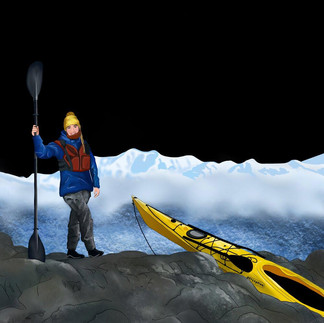Interview with Artist Amy Spencer Harff
- Michelle Fung

- May 3, 2022
- 7 min read

Tell us about yourself! Where are you based? What is a typical day like for you?
I am currently based just outside of Boston, Massachusetts (USA) at a boarding school. I grew up in Rhode Island and spent the past four years living in Upstate NY.
I am actually a middle school science teacher, so no two days are the same! One of my favorite things about working with middle schoolers is that I can incorporate art or creative projects into most of my environmental science classes. Students have made posters, designed 3D models, created comic strips and even built towers out of straws. It’s really important for me as a teacher to show students that there are many ways to communicate important concepts like climate change, and that art is just as useful of a tool as writing.
When I’m not working, I make wire art and prints for my Etsy shop @Shop SPNCR, and research environmental artists around the world. In August, I will leave for a one-year Thomas J. Watson Fellowship to make art with and learn from climate change and environmental artists in New Zealand, Taiwan, Germany, Malawi and Equador. Planning for this has been consuming a lot of my time recently so I haven’t been making as much art, but I’m so excited to devote a whole year to meeting artivists and making my own work.
Your body of large climate change illustrations is beautiful and reminds me of botanical and zoological illustrations. How do you use that visual language to convey your message?
It’s important for me to make art that draws the viewer in. I went to college in a rural conservative area and I figured that if the images were inviting, then the locals might be more receptive to learning about how climate change is projected to impact their community. I used to think that if people just knew the facts then things would change, but we’ve had the climate science data for decades, so clearly that hasn’t worked. Maybe these illustrations can help us connect to climate change on a personal level because it’s harder to unsee images than it is to forget facts.
When I started this project, I thought that I would be making large sculptures out of recycled materials, but after several months of failure, I went back to what I’ve always enjoyed most: drawing. I relish the crisp, dramatic lines and the fine detail that can be achieved with a pen. Given my environmental focus, I also wanted to use as few materials as possible (I still went through about 14 pens!). The finished product is as much about the art as it is about the accompanying information which I hope can be a tool to educate and inspire.
How did you come with the project idea for Changemakers? Tell us a bit more about the project!
Changemakers came out of my desire to fight the climate crisis and my absolute confusion on how to best do that. I was entering my senior year of college and was still trying to figure out what career to pick. When I went to my school’s career counselor, she told me all about the great jobs in economics or business, but when I asked about environmental jobs she had no answers. I realized that if I was struggling to find information about environmental/climate change focused jobs, I probably wasn’t the only one.
A great way to see what people are doing in the industry? Interview them! I ended up interviewing 25 women in over 17 countries to show that there is no one way to fight the climate crisis. There are scientists, environmental justice activists, politicians, lawyers, CEOs, youth activists, climate artists and even Paralympian athletes who are all working hard and breaking barriers along the way. These changemakers have jumped through invisible hurdles by being women, and especially by being women of color, disabled or trans, and yet they never gave up.

Given my art focus, it was only natural that I include portraits of the women. I’d never used Procreate before, so this was a real learning experience. I spent over 10 hours on some of the illustrations alone! One of my favorite parts of this experience was asking the women how they wanted to be depicted. I’d have them send me photos and then would also incorporate elements from their stories. Dominique Thomas, for example, wanted to be depicted in an Afrofuturistic style, so she sent me some Afrofuturism images for inspiration.
How did you pick these women to feature? Did you have to let go of some favourites?
Lots of research and many, many emails! And on zoom. Each zoom interview lasted anywhere from 30 minutes to nearly three hours! It was great to see just how many women are involved in environmental action and climate work around the world, so naturally, there are a lot of women that I’d still love to interview (looking at you Vandana Shiva and Rhianna Gunn-Wright).
Part of the challenge has been making sure that there is a diversity of voices included in the book. The environmental movement has traditionally been Eurocentric and cis white male-dominated, so I want to show that climate activism it is for everyone. We are going to need all hands on deck to turn this ship around so there’s no point in being exclusive! You might be thinking, “True, but then why did you just focus on women?” Because women are on the frontlines as community leaders and caretakers, and are often excluded from decision-making processes. According to the UN, women are also more vulnerable to climate change induced events because of higher poverty rates, systemic violence and gender inequality.
I know it’s impossible to choose your favourite portrait but tell us your favourite story.
This is a hard one. I’d almost rather say a few of my favorite portraits than my favorite stories because they are all so different!

If I had to pick one story, though, I’d talk about Nana Firman. In 2004, following a magnitude 9.1 tsunami in northern Sumatra, Nana was sent to there to help as a reconstruction designer. Her job was to plant mangroves to provide a natural barrier for future tsunamis, but the community had just lost everything and wasn’t interested in her planting project. After months of struggling to connect with the locals, a friend suggested that she use the Qur’an to explain why we should care about the environment. To Nana’s surprise, the scripture passages helped Nana connect with the community and changed their understanding of the mangroves. By focusing on what mattered most to them, Nana was able to inspire others to care about the environment too.
I’ve often thought about this story because it shows the importance of meeting people where they are instead of trying to force our ideas upon them. This message has influenced my own approach to environmental art and teaching. In both of these areas, I try to figure out what people care about and then focus my teachings or artwork on that.
Where can we buy this book?
Honestly the hardest part of this project has been publishing it! I’m still in the process of getting published, but if anyone wants a sneak peak, they are welcome to check out my website: https://www.amyspencerharff.com/current-project
As an educator, how do you educate the younger generation on our dire environmental problems? What advice do you have for parents?
I am lucky to work in a school that gives me a lot of flexibility with my curriculum, so my whole 8/9th grade course is environmental science focused. For the month of February, we learned about environmental justice issues like the Flint water crisis and then studied environmental injustices in our own community. We’ve also studied glacial retreat, deforestation, and ocean acidification, among many other topics, but I focus on what my students are most interested in. If they don’t feel that what we are learning is relatable to them, then they won’t be interested in it.
Unfortunately, many of my students feel hopeless and powerless about climate change. I think that they’ve been bombarded with doomsday messaging for so long that they are almost numb to it. Instead of adding to that, I’ve been trying to show the students what people are doing so that they can see that there are many ways to get involved. While I don’t shy away from the hard facts of climate science, I think that it is important equally important to show students that can make a difference.
I’m spearheading the eco club at my school and we have partnered with a local pig farm to give them our food scraps. We are also restarting the garden to help students reconnect with nature and learn about regenerative agriculture.
For parents who want their kids to care more about the environment, I think that following your child’s interests is important. If they start taking an interest in composting, see if there is a municipal composting program or if you can bring your compost to a farm or school. Perhaps they are more interested in sustainable fashion, so teach them how to sew so that they can repurpose thrifted clothing. There’s so many ways to be involved in environmental action and there’s lots of great resources out there!

Anything else?
I’m always interested in hearing about what other artists are up to, so please reach out! I’m going to be spending all of next year traveling to meet with artists so if you have any suggestions on who to contact, let me know. I’ll be posting my adventures and findings on my website so you can subscribe there if you want to follow along on my journey.
How can people find you?
The best ways to stay in the loop with my artwork and book are through my website https://www.amyspencerharff.com/, Instagram (@amyharff and Tiktok @__spncr).
✵✶✺
Enjoyed this interview? Leave a comment below! And don't miss the next one and get it right in your mailbox.
Make sure you sign up for my artistic love notes.
Plus, I give away a piece of art with every love note I send out. Yes, you heard me right. That's over 30 pieces of art every year! Only to my most loyal fans. Of course exclusive launch discounts as well! Get it now!



















As a student fascinated by environmental science and creative learning, I found this post truly inspiring. Business Intelligence Assignment Help has helped me analyze data and trends in science projects, and combining that with creative approaches like art seems like a fantastic way to engage students. Your examples of posters, 3D models, and comic strips show how learning can be both informative and fun. I admire your dedication to exploring environmental art globally, and Native Assignment Help Australia has guided me in connecting creativity with structured learning, making assignments more meaningful and insightful.
Bank transfers with Bivial turned out to be one of the most reliable ways with accepting payments online. I was impressed with how seamless the system is – no unnecessary delays or complications. My clients also feel more comfortable paying this way since it’s a method they already trust. For me, it’s a win-win: they get convenience, and I get security and fast processing. It’s definitely one of the features that makes Bivial stand out.
Another wonderful interview, with a very soulful artist, and human! Ms Harff's philosophy regarding her art, her work with young people, the critical messages she provides to them, and to all who are exposed to her art, is very inspiring. Amy's regard for the importance of inclusion of all peoples and cultures (humanity) as being a critical component to the solutions for climate change, as well as the many environmental stresses that our planet is under, is a powerful message of Hope and Love. Sharing this message with our young people, and their capacity to receive and understand these critical issues is truly a Hope Builder. Thank you Ms Harff. As a fellow New Englander (New Britain, CT), nature lover,…